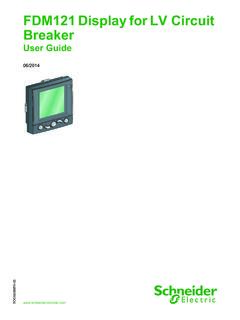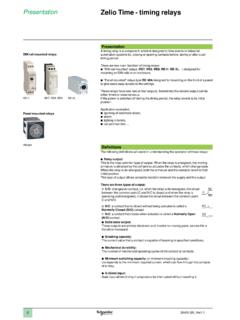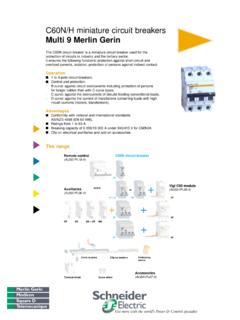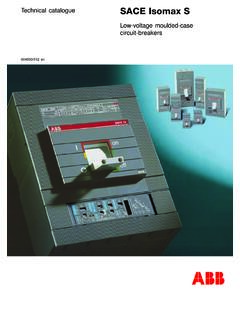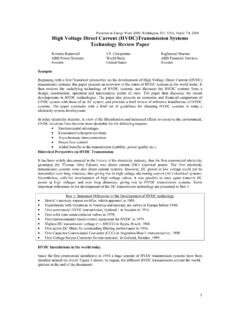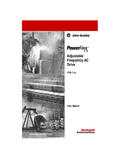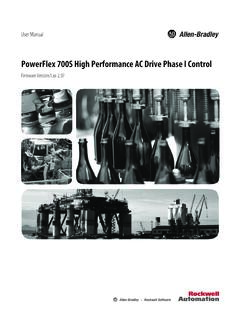Transcription of Calculation of Short Circuit Currents
1 Cahier technique no. 158 Calculation of Short -circuitcurrentsB. de Metz-NoblatF. DumasC. PoulainCollection TechniqueBuilding a New Electric World"Cahiers Techniques" is a collection of documents intended for engineersand technicians, people in the industry who are looking for more in-depthinformation in order to complement that given in product , these "Cahiers Techniques" are often considered as helpful"tools" for training provide knowledge on new technical and technological developmentsin the electrotechnical field and electronics. They also provide betterunderstanding of various phenomena observed in electrical installations,systems and "Cahier Technique" provides an in-depth study of a precise subject inthe fields of electrical networks, protection devices, monitoring and controland industrial automation latest publications can be downloaded from the Schneider Electric internetweb : :PressPlease contact your Schneider Electric representative if you want either a"Cahier Technique" or the list of available "Cahiers Techniques" collection is part of the Schneider Electric s"Collection technique".
2 ForewordThe author disclaims all responsibility subsequent to incorrect use ofinformation or diagrams reproduced in this document, and cannot be heldresponsible for any errors or oversights, or for the consequences of usinginformation and diagrams contained in this of all or part of a "Cahier Technique" is authorised with thecompulsory mention:"Extracted from Schneider Electric "Cahier Technique" no.." (pleasespecify).Beno t de METZ-NOBLATG raduate Engineer from ESE (Ecole Sup rieure d Electricit ), heworked first for Saint-Gobain, then joined Schneider Electric in is now a member of the Electrical Networks competency groupthat studies electrical phenomena affecting power system operationand their interaction with d ric DUMASA fter completing a PhD in engineering at UTC (Universit deTechnologie de Compi gne), he joined Schneider Electric in 1993,initially developing software for electrical network calculations in theResearch and Development Department.
3 Starting in 1998, he led aresearch team in the field of industrial and distribution 2003, as a project manager, he has been in charge of thetechnical development of electrical distribution POULAING raduate of the ENI engineering school in Brest, he subsequentedfollowed the special engineering programme at the ENSEEIHT institute in Toulouse and completed a PhD at the Universit Pierre etMarie Curie in Paris. He joined Schneider Electric in 1992 as aresearch engineer and has worked since 2003 in the ElectricalNetworks competency group of the Projects and Engineering 158 Calculation of Short -circuitcurrentsECT 158 updated September 2005 Cahier Technique Schneider Electric n 158 / low voltage area of conductors. Angle between the initiation of thefault and zero Power factor (in the absence ofharmonics).
4 EInstantaneous electromotive force (rms value). Phase angle (current with respect tovoltage).iInstantaneous sinusoidal component ofthe instantaneous component of theinstantaneous current (first peak ofthe fault current).ICurrent (rms value).IbShort- Circuit breaking current(IEC 60909).IkSteady-state Short - Circuit current(IEC 60909).Ik"Initial symmetrical Short - Circuit current(IEC 60909).IrRated current of a Short - Circuit current(Isc3 = three-phase,Isc2 = phase-to-phase, etc.). Factor depending on the saturationinductance of a factor (NF C 15-105)KCorrection factor for impedance(IEC 60909). Factor for Calculation of the peak Short - Circuit resistance of the resistance per unit kVA powertminMinimum dead time for Short -circuitdevelopment, often equal to the timedelay of a Circuit Short - Circuit voltage in %.
5 UNetwork phase-to-phase voltage withno nominal voltage with , in %, of rotating reactance of the reactance per unit reactance of a (1)Posititve-sequenceimpedanceZ(2)Negati ve-sequenceimpedanceZ(0)Zero-sequence impedanceZLLine upstream impedance for athree-phase impedance of the or k33-phase Short or phase-to-neutralshort Short / kE2E Phase-to-phase-to-earth Short set with on-load set without on-load a networkor Technique Schneider Electric n 158 / using symmetrical componentsCalculation of Short - Circuit currentsSummary1 Introductionp. The main types of Short -circuitsp. Development of the Short - Circuit currentp. Standardised Isc calculationsp. Methods presented in this documentp. Basic assumptionsp. 112 Calculation of Isc Isc depending on the different types of Short -circuitp.
6 Determining the various Short - Circuit impedancesp. Relationships between impedances at the differentvoltage levels in an installationp. Calculation examplep. 193 Calculation of Isc values in a Advantages of this methodp. Symmetrical componentsp. 23 Calculation as defined by IEC 60909p. Equations for the various currentsp. Examples of Short - Circuit current calculationsp. 284 Conclusionp. 32 Bibliographyp. 32In view of sizing an electrical installation and the required equipment, aswell as determining the means required for the protection of life andproperty, Short - Circuit Currents must be calculated for every point in Cahier Technique reviews the Calculation methods for Short -circuitcurrents as laid down by standards such as IEC 60909.
7 It is intended forradial and meshed low-voltage (LV) and high-voltage (HV) aim is to provide a further understanding of the Calculation methods,essential when determining Short - Circuit Currents , even when computerisedmethods are impedance methodCahier Technique Schneider Electric n 158 / IntroductionElectrical installations almost always requireprotection against Short -circuits wherever thereis an electrical discontinuity. This most oftencorresponds to points where there is a changein conductor cross-section. The Short -circuitcurrent must be calculated at each level in theinstallation in view of determining thecharacteristics of the equipment required towithstand or break the fault flow chart in Figure 1 indicates theprocedure for determining the various Short - Circuit Currents and the resulting parameters forthe different protection devices of a order to correctly select and adjust theprotection devices, the graphs in Figures 2, 3and 4 are used.
8 Two values of the Short -circuitcurrent must be evaluated:c The maximum Short - Circuit current, used todeterminev The breaking capacity of the Circuit breakersv The making capacity of the Circuit breakersv The electrodynamic withstand capacity of thewiring system and switchgearThe maximum Short - Circuit current correspondsto a Short - Circuit in the immediate vicinity of thedownstream terminals of the protection must be calculated accurately and used with asafety minimum Short - Circuit current, essentialwhen selecting the time-current curve for circuitbreakers and fuses, in particular whenUpstream Sscu (%)Iscat transformerterminalsIscof main LV switchboardoutgoersIsc at head of secondary switchboardsIscat head of final switchboardsIscat end of final outgoersConductor characteristicsb Busbarsv Lengthv Widthv Thicknessb Cablesv Type of insulationv Single-core or multicorev Lengthv Cross-sectionb Environmentv Ambient temperaturev Installation methodv Number of contiguous circuitsBreaking capacityST and inst.
9 Trip settingBreaking capacityST and inst. trip settingBreaking capacityST and inst. trip settingBreaking capacityInst. trip settingMain Circuit breakerMain LV switchboarddistribution Circuit breakersSecondarydistribution Circuit breakersFinal distribution Circuit breakers b Feeder current ratingsb Voltage dropsHV / LVtransformer ratingLoadratingscb Power factorb Coincidence factorb Duty factorb Foreseeable expansion factorFig. 1 : Short - Circuit (Isc) Calculation procedure when designing a low-voltage electrical installation (ST = Short time; Inst. = instantaneous)Cahier Technique Schneider Electric n 158 / Cables are long and/or the source impedanceis relatively high (generators, UPSs)v Protection of life depends on Circuit breaker orfuse operation, essentially the case for TN andIT electrical systemsNote that the minimum Short - Circuit currentcorresponds to a Short - Circuit at the end of theprotected line, generally phase-to-earth for LVand phase-to-phase for HV (neutral notdistributed), under the least severe operatingconditions (fault at the end of a feeder and notjust downstream from a protection device, onetransformer in service when two can beconnected, etc.)
10 Note also that whatever the case, for whatevertype of Short - Circuit current (minimum ormaximum), the protection device must clear theshort- Circuit within a time tc that is compatiblewith the thermal stresses that can be withstoodby the protected cable: i2 dtk A22 i (see Fig. 2, 3, and 4)where A is the cross-sectional area of theconductors and k is a constant calculated on thebasis of different correction factors for the cableinstallation method, contiguous circuits, practical information may be found in the Electrical Installation Guide published bySchneider Electric (see the bibliography). The main types of Short -circuitsVarious types of Short -circuits can occur inelectrical of Short -circuitsThe primary characteristics are:cDuration (self-extinguishing, transient andsteady-state)cOriginvMechanical (break in a conductor, accidentalelectrical contact between two conductors via aforeign conducting body such as a tool or ananimal)v Internal or atmospheric overvoltagesa5 sIz1 < Iz2t12I2t = k2S2 IFig.

